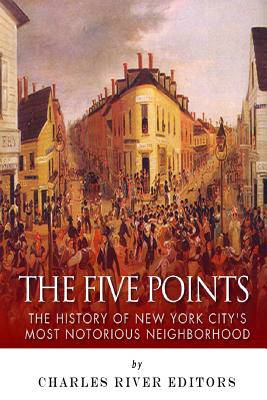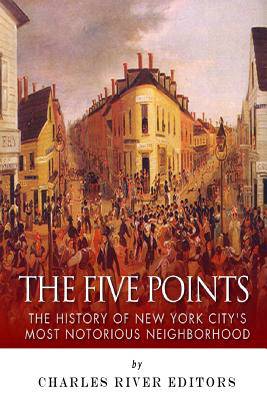
- Afhalen na 1 uur in een winkel met voorraad
- Gratis thuislevering in België vanaf € 30
- Ruim aanbod met 7 miljoen producten
- Afhalen na 1 uur in een winkel met voorraad
- Gratis thuislevering in België vanaf € 30
- Ruim aanbod met 7 miljoen producten
Zoeken
The Five Points
The History of New York City's Most Notorious Neighborhood
Charles River
Paperback | Engels
€ 17,95
+ 35 punten
Omschrijving
*Includes pictures *Includes accounts describing the neighborhood, the gangs, and the Dead Rabbits Riot *Includes a bibliography for further reading *Includes a table of contents "Brick-bats, stones and clubs were flying thickly around, and from the windows in all directions, and the men ran wildly about brandishing firearms. Wounded men lay on the sidewalks and were trampled upon. Now the Rabbits would make a combined rush and force their antagonists up Bayard street to the Bowery. Then the fugitives, being reinforced, would turn on their pursuers and compel a retreat to Mulberry, Elizabeth and Baxter streets." - New York Times, July 1856 Of all the great cities in the world, few personify their country like New York City. As America's largest city and best known immigration gateway into the country, the Big Apple represents the beauty, diversity and sheer strength of the United States, a global financial center that has enticed people chasing the "American Dream" for centuries. However, for all the promise and opportunities America seemingly held out, and for all of the nostalgia and pride the country's history invokes among Americans today, the simple truth is many never climbed the ladder. Hundreds of years spent trying to eradicate poverty has resulted only in gradual improvements, firm evidence that poverty will never be erased and poor people will be left to their own means of survival. That is how slums are born and maintained, and that is the story behind Five Points and the gangs that ruled it. The neighborhood's colloquial nickname came from its famous five-pointed intersection, created by Orange Street (now Baxter Street), Cross Street (now Mosco Street), and Anthony Street (now Worth Street). In many ways, Manhattan's notorious Five Points neighborhood represents the best and worst of the American Dream. The downtrodden area, full of recently arrived immigrants hoping to get ahead, was home to some of the most famous gangs and fights in New York City's history, from the Dead Rabbits to the Bowery Boys. At the same time, however, the neighborhood and its gangs have been romanticized as an inextricable part of New York's history, perhaps most notably in the critically acclaimed movie Gangs of New York. Given its history of rapid change, it's somewhat amusing that the city's inhabitants today often complain about the city's changing and yearn for things to stay the same, and over time, the Five Points changed much the way the rest of Manhattan did. By the end of the 19th century, the value of the real estate and the increase in the population compelled the city to transform the neighborhood by razing tenements and building newer and nicer structures. In the case of the Five Points, it could not have gotten a more radical or ironic makeover, as the impoverished area gave way to scenic parks and a host of administrative governmental buildings. The Five Points: The History of New York City's Most Notorious Neighborhood chronicles the famous and controversial story. Along with pictures of important people, places, and events, you will learn about the Five Points like never before, in no time at all.
Specificaties
Betrokkenen
- Auteur(s):
- Uitgeverij:
Inhoud
- Aantal bladzijden:
- 52
- Taal:
- Engels
Eigenschappen
- Productcode (EAN):
- 9781507583388
- Verschijningsdatum:
- 16/01/2015
- Uitvoering:
- Paperback
- Formaat:
- Trade paperback (VS)
- Afmetingen:
- 152 mm x 229 mm
- Gewicht:
- 81 g

Alleen bij Standaard Boekhandel
+ 35 punten op je klantenkaart van Standaard Boekhandel
Beoordelingen
We publiceren alleen reviews die voldoen aan de voorwaarden voor reviews. Bekijk onze voorwaarden voor reviews.











